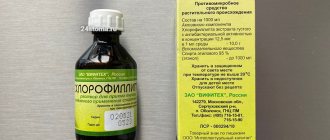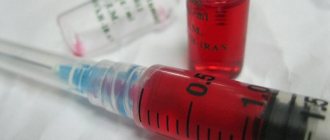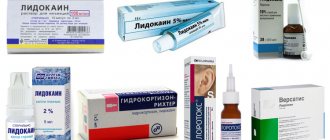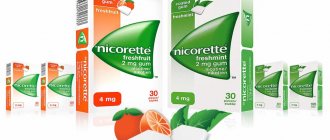Release form and packaging Puregon
The drug is available in the form of a solution that is administered intramuscularly or subcutaneously. Considering that the drug is administered according to the prescribed scheme, for convenience it is manufactured in cartridges that fit into special pens (Puregon Pen), which allows you to make injections yourself without much difficulty. Thanks to this form of release, a woman can administer it herself.
Cartridges come in several options: 0.36 ml, 0.72 and 1.08 ml and come with a set of needles. To reduce pain during an injection, as well as to use up the solution during manipulation, today they use syringes that come with small needles or a special Puregon pen. This is a special device that allows you to avoid leakage of the drug during manipulation by medical workers or self-use, because if the drug is not in full, accordingly, the dose that is required to stimulate ovulation will not be completely administered.
How to correctly set the dosage in pens?
Let's talk in more detail about pen syringes: how to use them correctly and how to correctly set the dose of the injected drug. This issue is very important, because incorrect administration of the drug dose can lead to a number of complications, including ovulation hyperstimulation syndrome, which is difficult to treat.
Before you start administering Puregon using a pen syringe, you should prepare a cartridge, pen, sterile disposable needle, alcohol for processing and cotton wool. The optimal place to store open cartridges is the refrigerator, from which you should remove the drug the day before. It can be stored in a room in a dark place for 90 days. A cartridge containing 300 IU of the drug will have a silver cap, a gold cap will contain 600 IU of the drug, and a cartridge with a blue cap will have 900 IU. Only the attending physician selects the dosage of the drug to stimulate ovulation. Before injection, wash your hands with soap twice, prepare the pen and remove the protective cap from it. Carefully remove the body from the pen, open the cartridge, treat it with a disinfectant and place it in a metal holder, then tighten it so that the yellow arrow on the body coincides with the black line on the base of the pen. This will indicate that the cartridge is inserted correctly. After making sure that the cartridge is filled correctly, put a sterile disposable needle on it, from which the protective film is removed and the needle is fixed by screwing it onto the base of the cartridge. After this, remove the cap from the needle and treat the skin. It is better to inject puregon subcutaneously into the abdomen in the fold under the navel or thigh, changing the location each time. After treating the injection site with a disinfectant, you need to let it dry and proceed with the injection itself. First of all, remove the cap from the needle, tap the cartridge to remove air bubbles, turn the handle until it clicks and press the button to inject and administer the drug, as a result of which a drop of liquid should appear.
Setting the dosage
After the syringe is filled, you need to select the dose of the drug. We will tell you how to do this now. So, turn the knob until your prescribed dose appears in the window. If you accidentally scrolled through the dose prescribed for you, then turn the handle all the way, and then press the handle, without losing a single drop. Having established the dose of the drug prescribed to you by your doctor, treat the skin and insert the needle into the subcutaneous fold. By pressing the handle, inject the marked dose, after which for several seconds without removing the syringe from the skin and making sure that the window on the syringe shows 0. After the injection, remove the needle from, close the handle and place it out of reach of children. You can use the started cartridge as long as there is enough drug for one injection. You will use a disposable needle every day and set the appropriate dose of the drug injected.
Puregon solution for subcutaneous administration 600 IU/0.72 ml n1 cartridge
Compound
Solution for subcutaneous administration 0.72 ml in a cartridge containing recombinant follitropin beta 600 IU, colorless glass with a volume of 1.5 ml complete with needles (6 pieces) in a plastic package in a cardboard box.
Mode of application
Treatment with Puregon 600 should be started under the supervision of a physician experienced in the treatment of infertility.
The dose should be adjusted individually depending on the response of the ovaries, under ultrasound control and estradiol concentration.
Puregon 600 is effective with a lower total dose and shorter treatment time required for maturation compared to urine-derived FSH, which minimizes the risk of developing ovarian hyperstimulation.
Overall experience in the treatment of infertility by in vitro fertilization indicates that success is most likely during the first 4 courses of therapy and gradually decreases thereafter.
For anovulation, a sequential treatment regimen is recommended, starting with daily administration of 50 IU of Puregon® for at least 7 days. In the absence of an ovarian response, the daily dose is gradually increased until follicular growth and/or an increase in plasma estradiol concentration is achieved, indicating that an optimal pharmacodynamic response has been achieved. A daily increase in plasma estradiol concentration by 40-100% is considered optimal.
The daily dose thus obtained is then maintained until the preovulation state is achieved. The state of preovulation is determined by the presence of a dominant follicle with a diameter of at least 18 mm (according to ultrasound) and/or a plasma extradiol concentration of 300-900 picograms/ml (1000-3000 pmol/l).
Typically, 7-14 days of treatment are required to achieve this state.
After this, the administration of the drug is stopped and ovulation is induced by administering hCG. If the number of follicles is too large or the estradiol concentration increases too quickly, i.e. more than 2 times per day for 2-3 consecutive days, then the daily dose should be reduced. Since each follicle with a diameter greater than 14 mm is preovulatory, the presence of several follicles with a diameter greater than 14 mm carries the risk of multiple pregnancies. In this case, hCG is not administered and measures are taken to protect against possible pregnancy to prevent multiple pregnancies.
To induce superovulation during artificial insemination, various stimulation schemes are used. For at least the first 4 days, it is recommended to administer 100-225 IU of the drug. After this, the dose can be selected individually, based on the reaction of the ovaries. Clinical studies have shown that a maintenance dose of 75-375 IU for 6-12 days is usually sufficient, but in some cases longer treatment may be required.
Puregon 600 can be used either alone or in combination with a GnRH agonist or antagonist to prevent premature peak ovulation. When using GnRH analogues, higher total doses of Puregon® may be required.
The reaction of the ovaries is monitored by ultrasound and determination of the concentration of estradiol in plasma. If there are at least 3 follicles with a diameter of 16-20 mm (according to ultrasound) and there is a good ovarian response (estradiol concentration in blood plasma 300-400 picograms/ml (1000-1300 pmol/l) for each follicle with a diameter of more than 18 mm), induce the final phase of follicle maturation by administering hCG. After 34-35 hours, oocytes are aspirated.
Rules for using the drug
To prevent pain during injection and to minimize leakage of the drug from the injection site, the solution should be injected slowly. It is necessary to alternate sites of subcutaneous injection to avoid the development of fatty atrophy. Unused solution should be destroyed.
Subcutaneous injections of Puregon® can be carried out by the woman herself or her partner, who has received detailed instructions from the doctor. Self-administration of the drug is permissible only for patients who have good skills and a constant opportunity to consult with a specialist.
The drug, produced in cartridges, is intended for administration using a Puregon Pen injector pen. In this case, the drug is administered subcutaneously.
When using the Puregon Pen injector pen, it must be taken into account that the pen is a precise device that releases the dose set on it. It has been shown that using an injector pen delivers 18% more FSH than using a syringe. This may be significant, in particular, when changing an injector pen to a regular syringe, and vice versa, in the same treatment cycle. Some dose adjustment is especially necessary when switching from a syringe to a pen to avoid an unacceptable increase in the administered dose.
The drug, available in vials, is intended for administration using a syringe.
Step 1 - Preparing the syringe
To administer the drug, disposable sterile syringes and needles should be used. The volume of the syringe must be small enough to deliver the prescribed dose accurately. If the solution is opaque or contains mechanical inclusions, it cannot be used. The contents of the bottle should be used immediately after piercing the rubber stopper. The solution remaining after a single use is discarded. First, remove the valve from the bottle cap. Place the needle on the syringe and pierce the rubber stopper of the bottle with the needle. Draw the solution into the syringe and replace the needle with an injection needle. Holding the syringe with the needle up, gently tap it on the side to displace air bubbles into the upper part of the syringe, then press the piston until the air is completely removed, until only the Puregon® solution remains in the syringe. If necessary, additional pressure on the piston is used to set the volume of the solution intended for administration.
Stage 2 - Injection site
The most suitable place for subcutaneous injection is the abdominal area around the navel with mobile skin and a layer of fatty tissue. With each injection, you should change the injection site slightly. The drug can be injected into other areas of the body.
Stage 3 - Preparing the injection site
To reduce discomfort when inserting a needle, you can make several claps at the site of the intended injection. Hands should be washed and the injection site should be wiped with a disinfectant solution (for example, 0.5% chlorhexidine) to remove surface bacteria. Apply approximately 6 cm around the point where the needle will enter and wait about a minute for the disinfectant solution to dry.
Step 4 - Inserting the needle
Pull the skin back a little. With your other hand, insert the needle at a 90° angle under the surface of the skin.
Step 5 - Checking the correct needle position
When the needle is positioned correctly, the piston is quite difficult to return.
Blood seeping into the syringe indicates that the needle has pierced a vein or artery. In this case, remove the syringe, cover the injection site with a swab containing disinfectant liquid and apply pressure, and the bleeding will stop in 1-2 minutes. Do not use the solution and remove it from the syringe. Start again from step 1, using a new needle and syringe, and a new bottle of the drug.
Stage 6 - Introduction of the solution
Lower the plunger slowly and gradually to ensure proper injection of the solution without damaging the skin tissue.
Step 7 - Removing the syringe
Quickly remove the syringe, cover the injection site with a swab containing disinfectant liquid and apply pressure. Gently massaging this area (with constant pressure) will help distribute the Puregon® solution and help avoid discomfort.
Indications for use
Treatment of female infertility in the following cases:
- anovulation (including polycystic ovary syndrome (PCOS) in women unresponsive to clomiphene treatment;
- induction of superovulation, to induce multiple development of follicles during artificial insemination (for example, in IVF/PE, IUI and ICSI techniques).
Contraindications
- tumors of the ovaries, breast, uterus, pituitary gland and hypothalamus;
- vaginal and uterine bleeding of unknown etiology;
- primary ovarian failure;
- ovarian cysts or enlarged ovaries not associated with PCOS;
- violation of the anatomy of the genital organs, incompatible with pregnancy;
- uterine fibroids incompatible with pregnancy;
- decompensated diseases of the endocrine system (for example, diseases of the thyroid gland, adrenal glands or pituitary gland);
- severe dysfunction of the liver and kidneys;
- pregnancy;
- lactation period;
- hypersensitivity to any of the components of the drug.
Pharmacological properties
Recombinant follicle-stimulating hormone (FSH), which is obtained using recombinant DNA technology using a culture of Chinese hamster ovary cells into which the genes for human FSH subunits are introduced. The primary amino acid sequence of the recombinant DNA is identical to that of natural human FSH. However, there are slight differences in the structure of the hydrocarbon chain.
FSH ensures normal growth and maturation of follicles and the synthesis of sex steroid hormones. The level of FSH in women is a factor that determines the onset and duration of follicular development, as well as the time of their maturation. Thus, the drug Puregon® can be used to stimulate the development of follicles and estrogen synthesis in certain disorders of ovarian function. In addition, Puregon® is used to induce multiple follicular development during artificial fertilization (for example, in vitro fertilization/embryo transfer (IVF/ET), intrauterine insemination (IUI) and intracytoplasmic sperm injection (ICSI). After treatment with Puregon ® human chorionic gonadotropin (HCG) is usually administered to induce the final stage of follicular maturation, resumption of meiosis, and ovulation.
Pharmacokinetics
After intramuscular or subcutaneous administration of the drug Puregon® Cmax, FSH in the blood plasma is achieved within 12 hours. Due to the gradual release of the drug from the injection area and the long T1/2 (from 12 to 70 hours, on average 40 hours), the FSH content remains elevated within 24-48 hours, and therefore repeated administration of the same dose of FSH leads to a further increase in FSH concentration by 1.5-2 times compared with a single administration. This allows you to achieve a therapeutic concentration of FSH in the blood.
Pharmacokinetic parameters after intramuscular and subcutaneous administration of Puregon® do not differ significantly. With both routes of administration, the bioavailability of the drug is approximately 77%. Recombinant FSH is biochemically similar to FSH isolated from human urine and is distributed, metabolized, and excreted from the body in a similar manner.
Pregnancy and lactation
The use of Puregon® during pregnancy and breastfeeding is contraindicated. Due to the fact that there is insufficient clinical data on the use of the drug during pregnancy, in case of unintentional use during pregnancy, the teratogenic effect of recombinant FSH cannot be excluded.
Side effects
Local reactions: hematoma, pain, hyperemia, swelling, itching (observed in 3 out of 100 patients treated with Puregon®). Most of these reactions are mild and transient.
Systemic allergic reactions: erythema, urticaria, rash and itching (observed in 1 out of 1000 patients treated with Puregon®).
From the reproductive system: ovarian hyperstimulation syndrome (approximately 4 out of 100 women receiving treatment with the drug), soreness, pain and/or engorgement of the mammary glands, spontaneous abortion; increased likelihood of developing multiple pregnancies, increased likelihood of ectopic pregnancy.
Clinical symptoms of moderate ovarian hyperstimulation are nausea, diarrhea, bloating and abdominal pain due to impaired venous circulation and irritation of the peritoneum, as well as enlargement of the ovaries due to cysts. In rare cases, severe ovarian hyperstimulation syndrome was observed, which threatened the patient's life and was characterized by the presence of large ovarian cysts prone to rupture, ascites, hydrothorax and weight gain due to fluid retention in the body. In rare cases, ovarian hyperstimulation syndrome may be accompanied by the development of venous or arterial thromboembolism.
From the digestive system: nausea, vomiting (approximately 1 in 100 women receiving treatment with the drug).
When treated with Puregon® in combination with hCG, as well as when used with other gonadotropic hormones, in rare cases, thromboembolism may develop.
Overdose
There are no data on acute overdose of Puregon®. The use of FSH in high doses can lead to the development of ovarian hyperstimulation syndrome, the symptoms of which are described above.
Treatment: if symptoms of unwanted hyperstimulation (not associated with induction of superovulation during in vitro fertilization) appear, administration of Puregon® should be discontinued. In this case, measures should be taken to protect against the development of pregnancy and the administration of hCG should be abandoned, which may aggravate adverse events. Treatment should be aimed at eliminating the symptoms of ovarian hyperstimulation syndrome.
Interaction with other drugs
The simultaneous use of Puregon® and clomiphene may enhance the ovarian response.
After desensitization of the pituitary gland with GnRH agonists, a higher dose of Puregon® may be required to achieve a sufficient ovarian response.
Pharmaceutically incompatible with other drugs.
special instructions
Before starting treatment, the presence of endocrine diseases (for example, diseases of the thyroid gland, adrenal glands or pituitary gland) should be excluded.
Induction of ovulation with gonadotropic drugs increases the risk of developing multiple pregnancies. Appropriate adjustment of the FSH dose prevents the development of multiple follicles. In multiple pregnancies, there is a higher risk of complications during pregnancy and in the perinatal period. Before starting treatment, patients should be warned about the possibility of developing multiple pregnancies.
The first administration of Puregon® should be carried out under the direct supervision of a physician.
Women who undergo artificial insemination (especially IVF) often have fallopian tube abnormalities, which increases the risk of developing an ectopic pregnancy. Therefore, it is important to obtain early ultrasound confirmation of the intrauterine location of the fetus.
Women who undergo artificial insemination have a higher risk of early miscarriage than with natural conception.
The incidence of congenital malformations with assisted reproductive technologies (ART) may be slightly higher than with natural fertilization. This may be due to the characteristics of the parents (for example, their age or sperm characteristics), as well as the higher incidence of multiple pregnancies when ART is used. There has been no evidence that an increase in the risk of congenital malformations is associated with the use of gonadotropins.
Before starting treatment and regularly during treatment, ultrasound should be performed to monitor the development of follicles and determine the concentration of estradiol in plasma. In addition to the development of too many follicles, the concentration of estradiol in plasma can increase very quickly (i.e., more than 2 times per day for 2-3 consecutive days), reaching excessively high values. The diagnosis of ovarian hyperstimulation can be confirmed by ultrasound. Transient abnormal liver function tests may indicate liver dysfunction, which may be accompanied by morphological changes on liver biopsy, as has been reported in association with ovarian hyperstimulation syndrome.
Women at recognized risk for thrombosis, such as those with a relevant personal or family history, significant obesity (body mass index > 30 kg/m2) or diagnosed thrombophilia, may be at increased risk of venous or arterial thromboembolism when treated with gonadotropins, even without concomitant hyperstimulation syndrome ovaries. When treating such women, it is necessary to compare the likelihood of successful ovulation induction and the possible risk of complications. However, it should be noted that pregnancy itself is accompanied by an increased risk of thrombosis.
Puregon® may contain traces of streptomycin and/or neomycin. These antibiotics may cause a hypersensitivity reaction.
Impact on the ability to drive vehicles and operate machinery
Not detected.
Storage conditions
The drug should be stored in a place protected from light, out of reach of children, at a temperature of 2° to 8°C; do not freeze. Shelf life: 3 years.
Once the needle is inserted into the cartridge, the solution can be stored for a maximum of 28 days.







